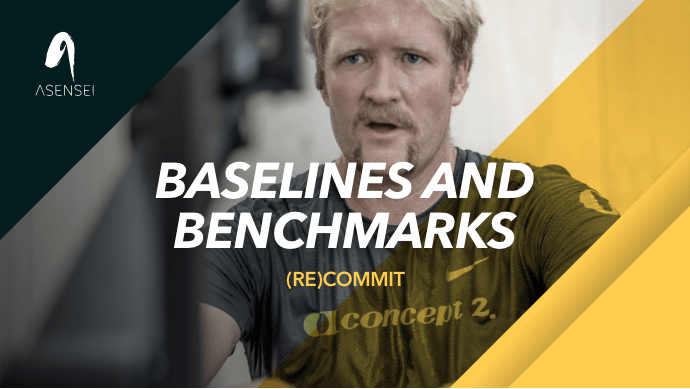To get where you want to go, you need to know where you began - that's your baseline. Benchmarks are a great way to understand where your performance lies at a particular time and when used in a wider context can help you understand what is realistic and achievable. The combination of baselines and benchmarks can help guide your indoor rowing training and drive significant performance improvements. It's great to track your progress from the first baseline to understand how much you've grown and improved. In this fourth article of our (RE)COMMIT series Olympic legend Eric Murray talks through how and why you should set baselines to maximise your progress during rowing training.
Table of Contents
Train smart, not hard
It's important to train smart, not just hard - it's a cliche, but it's true. When done correctly benchmarks help you avoid exercising mindlessly, without purpose and focus. Having specific goals and to-do lists in your workout will help you grow and improve and track exactly what you need to hone in on each session. This keeps you accountable for each workout, helps you strive to continuously improve and better yourself by reminding you of your starting point.
While you can complete a baseline workout at any time, they’re particularly effective at establishing a starting point when you begin a new training programme. If you want to test your cardio capacity or skill, your first baseline workout should be related to the activity you’re training for. For example if you want to row a sub-8-minute 2k, your benchmark should help to indicate how fast you can row a 2k today (your baseline). This doesn't always mean rowing exactly the same distance or time, it can also be a test that allows you to estimate your 2000m time.
Baselines in the (RE)COMMIT Program
In the (RE)COMMIT 2000m interactive training program asensei and Eric Murray test your fitness in the first week in the SPRINT FINISH workout and then again midway through the program in WATERSHED with 1000m max effort rows. Those baseline rowing tests are used to predict your 2000m time for the end of the (RE)COMMIT program in the EMPTY THE TANK workout. Together with the asensei rowing app's continuous assessment of your rowing performance these baselines give remarkably good insights into your expected outcome. You can find out more about how effective this is in the secrets to a faster 2000m and we continue to optimise the system and make it better.
Benchmark and improve
Your overall training routine shouldn't consist of only performing your target workout, nor just a set of baseline tests. A holistic and varied training program should address not just the goal, but also the fundamental technique areas and muscle groups that support your rowing. For example you can develop your rowing technique through drills and focussed practice, develope speed through interval workouts and stamina through longer low rate pieces. You may also build your glutes & quads through strength training and work on mobility in your hips by practicing different hinging movements. By developing your fitness, technique, strength and mobility, when you perform the baseline workout again, you’re much more likely to see progress every time.
For example the asensei (RE)COMMIT program provides a balance of different workout types structured to build you towards a 2km test and you'll learn technique as you row. You'll also find strength and mobility exercises available in the asensei app and the DRILLS AND SKILLS program will help you double down on areas of your technique that need attention.
In the video below Eric Murray talks about how you might go about balancing your own goals with realistic expectations and how asensei can help you to get faster.
Eric Murray discusses the importance of baselines and benchmarks and how asensei makes this easy
What's a good rowing 2000m time? External Benchmarks
It can be interesting to benchmark your 2000m time against some external factors, there are a number of ways you can do this and we've pulled together some useful resources. A full discussion of this topic is probably an article in itself, but we'll try and keep this high level and cover some of the key factors you should consider when trying to establish an external benchmark.
Factors that affect rowing performance
There are many factors that affect rowing performance including If you want to aim really high you can take a look at the rowing 2000m world records, these are maintained by Concept 2, and handily enough are broken down by gender, weight category and age group so you can get an idea of where you stand. And while most of us can only dream of these times, they do provide an indication of how the various different factors listed can affect performance.
In the female category the heavyweight 2000m rowing world record time is held by Brooke Mooney of the USA with a time of 6:21.1 (6 minutes, 21.1 seconds) while in the female lightweight category the world record 2k time belongs to Jennifer Casson of Canada in a time of 6:53.8 - which is a pretty significant difference, over 32s - or about 8.5% slower, showing that weight is a significant factor. Age is also a factor, with both of those world leading athletes falling into the 19-29 age category when setting the overall world bests while the records for over 50s are 6:58.0 for the heavyweight category and 7:18.3 for the lightweight category, both being around 30s slower than the open age category best times.
In the men's 2000m categories we see similar benchmark trends, with perhaps slightly compressed time differences. Josh Dunkley-Smith of Australia is the fastest heavyweight male rower over 2km, with a phenomenal time of 5:35.8 and 5:56.7 is the fastest time by a lightweight, set by Henrik Stephansen of Denmark. And the over 50s are a bit slower at 6:01.7 for heavyweight and 6:25.0 for the lightweight category.
As well as World Records, Concept 2 also provide a live RowErg ranking system, which lets you see a whole population of rowers ranked in order of performance. Importantly this isn't just elite athletes (although they appear too) it includes club rowers and home rowers of all standards and levels of experience. These rankings can be sorted by wight, age, gender, country, year, adaptive and can help you put your performance into context and you'll almost certainly find there are plenty of rowers both above and below your times!
Another interesting external benchmark comes from this site, rowing level which attempts to normalize times by ability, age and gender. For example the site suggests that a 50 year old female at a beginner level might be averaging around 11:05.6 for a 2000m, which compares to the world record of around 6:58. The ability category used is partly a proxy for how good your technique and fitness is, partly a way of segmenting the overall population of rowers, but what it really demonstrates that there is a vast range of performance possible. Don't be demoralized even if your current times are high compared to external benchmarks, instead take heart from the fact that larger performance gains are likely to be possible with the correct training.
Set your own baseline
While world records and external factors are interesting benchmarks, most of us will be fighting our own battles at much slower times and just trying to be the best we can be at that point in time. That is a key reason why at asensei we personalize our programs based upon your actual performances when rowing through our workout programs.
Conclusion
Every time you perform a benchmark test, you can measure your progress. How much you improve over the course of your training program depends on your baseline levels, if you’re a complete beginner with low fitness levels, you will tend to see significant improvements after a short period of time. However, more experienced athletes will find the improvement between tests closes as they grow stronger and fitter. You may improve by minutes between your first and second 2k test, whereas you might only shave off a couple of seconds between your tenth and eleventh tests. This is normal and where a good coach (or connected coaching app like asensei) can help through recommending new areas to work on, or new ways to tackle a particular theme - helping you to continue to improve through the aggregation of marginal gains.
Articles in the (RE)COMMIT Series
#1 Connected Coaching with asensei
#4 Baselines & Benchmarks (this article)
DOWNLOAD ASENSEI ROWING TODAY
asensei rowing is free to download and you can trial the first 3 workouts in the (RE)COMMIT program and let Eric calculate a 2k time that he can coach you to achieve in only 6 weeks. All you need is an iPhone and access to an asensei Compatible rowing machine from Concept 2, WaterRower or FluidRower with a bluetooth capable monitor. | |
Sign up for an asensei rowing membership today!
ASENSEI ROWING

$150.00 USD
ANNUAL BILLING TO SAVE YOU $$$ Equivalent to just $11.25/month*, money back within 30 days if not satisfied. Or sign up for a flexible monthly plan. Additional discounts only show up on CART page. AMAZING TRAINING APP “The app monitors… Read More





